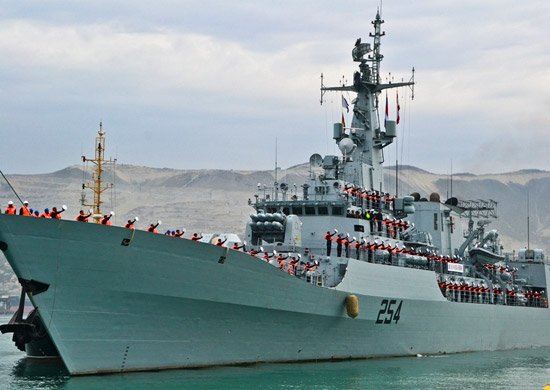At least four Chinese frigates, F-22P commissioned in July 2009, are giving nightmares to Pakistani Navy officers and men tasked to keep them afloat in the turbulent waters of Arabian Sea and Indian Ocean. Three of these frigates were bought from the China Shipbuilding Trading Company, while one was built at the Karachi Shipyard and Engineering Works on the basis of a technology transfer from the Chinese company.
Frigates are two of the most common warships in a navy’s fleet, the other being destroyers. Both are deployed for quick manoeuvrability and are used by navies to escort and protect larger vessels from air, surface and underwater threats. They are equipped with the latest weapons and defence systems, which are vital for their main roles of escorting and protecting large vessels. Some navies use frigates in an anti-submarine mode as well as for short-range air defence.
In 2005, Pakistan had signed a $750-million deal with China to design and construct F-22P or Zulfiquar class 2,500t multi-mission, conventionally powered frigates, which were delivered between September 2009 and April 2013. The Pakistan Navy had set the following mission objectives for these frigates: air defence of a force operating at sea or in convoy; interdiction of hostile surface combatants; commerce raiding, patrolling, protection of the exclusive economic zone (EEZ); and undertaking heliborne operations. This means that the frigates are equipped to operate in multi-threat environments and are equipped with long-range, surface-to-surface and surface-to-air missiles.
After the commissioning of the frigates, the Pakistani Navy found out that the on-board imaging device of the FM90 (N) missile-system was defective because of a faulty indication on display. The system was unable to lock on to the target which, in a way, made the missiles ineffective, thereby defeating one of the critical mission objectives. As it turned out, these ships were found to be equipped with a defective infra-red sensor (IR17) system and SR 60 radars, two of the most important sensors on board, which are used for air and surface search. These search and track radars were found to exhibit faults during high-power transmissions, substantially degrading its operational utility. The IR 17 sensors on all the ships were found to be defective and had to be discarded, with the replacement yet to be fitted.
Another set of common faults in the Chinese-built frigates were found in its main engines. These frigates are powered by four diesel engines. A critical engine defect has been low engine speed caused by high turbocharger exhaust temperatures, especially in engines 3 and 4, on all the frigates. High degree of degradation was noticed in the engine crankcase and liner which undermined the coolant chemistry in the ships. Lube oil degradation and deterioration of vibration isolators were some other faults in the engines.
There were other specific deficiencies in different ships. PNS Aslat, for instance, exhibited poor radar performance. The ASO-94 Sonar system on Aslat was erratic in its performance and on inspection it was found it was caused by faulty computing units. Likewise, Aslat’s SR-47 BG Search Radar was below par in performance and repairs were carried out with cannibalised parts from other F22P ships. The ASO-94 Sonar on board PNS Zulfiqar was reportedly picking up false contacts, caused by high noise levels radiated by the ship. The frigate developed a serious snag during an operational deployment in the Gulf of Aden. The port rubber blade of the frigate was dislodged causing it to be grounded for a period of time. The Vice Chief of Naval Staff, Pakistan Navy, expressed great concern over the issue to the head of the shipping company and asked to be compensated for the loss of operational time
An equally serious deficiency noticed in PNS Zulfiqar, the first Chinese frigate to be commissioned, was the NG 16 single barrel 76mm gun mounted on it. The gun, equipped to engage other ships and aircraft and defend against anti-ship missiles, developed numerous faults in the mechanical and electrical parts, severely limiting its utility. PNS Saif has been running with a problematic HP5 stabiliser gyro since its commissioning. A gyroscopic fin stabilizer, found on both sides of a ship’s hull, prevents excess rolling of a ship, in either direction. The Chinese firm admitted that the fault was caused by defective Gimball Assembly motors, These motors were yet to be repaired or replaced, endangering the ship’s berthing operations
Defective critical components and poor service from Chinese manufacturers have forced the Pakistani Navy to operate these four frigates with degraded operational capabilities, compromising some of the key mission objectives with which these ships were bought at a high price
At least four Chinese frigates, F-22P commissioned in July 2009, are giving nightmares to Pakistani Navy officers and men tasked to keep them afloat in the turbulent waters of Arabian Sea and Indian Ocean. Three of these frigates were bought from the China Shipbuilding Trading Company, while one...

www.geopolitica.info








